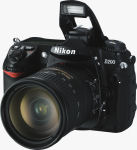 Nikon announces D200 digital SLR
Nikon announces D200 digital SLR
By
Mike Tomkins
(Tuesday, November 1, 2005 - 01:00 EST)
As some of our readers will doubtless have been expecting, after two leaks on the company's websites overseas in the last week, Nikon USA has today announced its new D200 digital SLR.
A long-anticipated refresh to the original D100 model that was announced just a few months short of four years ago, the D200 looks set to offer strong competition to rival Canon's heretofore dominant EOS 20D model, as well as the current top models from the other players in the digital SLR market - Fujifilm, Konica Minolta and Pentax. The D200 will doubtless attract the most attention for its use of a newly developed 10.2 effective megapixel CCD image sensor, which courtesy of its Nikon DX format dimensions gives a 1.5x focal length crop compared to 35mm film. ISO sensitivity ranges from 100 to 1600, with the ability to extend the range to 3200. Perhaps more impressive though is the camera's burst shooting capability - five frames per second for a whopping 37 JPEG or 22 RAW frames. The camera is equally speedy in other areas. Shutter speeds range from 1/8000 second to 30 seconds, plus bulb, and Nikon says it powers up in just 0.15 seconds. Shutter lag is quoted at 50 milliseconds, and viewfinder blackout at 105 milliseconds. A newly developed phase detection Multi-CAM1000 module features 11 focusing points, and can be switched to a wide AF mode with seven focusing points. A 1,005-pixel RGB exposure / Color Matrix Metering Sensor provides for 3D Color Matrix Metering II as seen in the Nikon D2x, which decides on metering of a scene by combining measurements of brightness, color, contrast, focus area and camera-to-subject distance for comparison against a database based on 30,000 real-life scenes. The D200 also has some other fairly interesting features that include the ability to combine up to 10 separate images into a single composite image in-camera, or to overlay two RAW images with control over opacity, and save the results to JPEG, TIFF or even RAW format as a new file. New image optimisation functions allow the photographer to control sharpening, tone / contrast, color, saturation, and hue, with preset choices including Normal, Softer, Vivid, More Vivid, Portrait, Custom and Black-And-White. Images can be reviewed on a large, high resolution 2.5" LCD display with a 170-degree viewing angle and 230,000 pixels, which is also used to access the newly developed LCD menu system. An LCD info display that Nikon says is the largest among cameras in the D200's class allows for quick and easy confirmation of camera settings. PC connectivity is catered for with a USB 2.0 High-speed port, while an optional WT-3 wireless lan module provides for 802.11b/g networking. An optional GPS Adapter Cord allows images to be tagged with latitude, longitude, elevation and UTC time data from a GPS receiver. Battery life is said to be improved courtesy in part of a new EL-EL3e Lithium Ion battery that allows up to 1,800 images to be captured on a charge. Information on battery life is also improved, with a real-time "Fuel Gauge" system that informs the user not only of overall battery status, but of remaining charge by percentage, and the number of shots taken since the last charge. An optional MB-D200 battery pack allows two EL-EL3e batteries to be used at once, or alternatively for the camera to be powered by six AA batteries, and also adds an additional command dial and shutter release button. The D200 is also designed for durability, with an enhanced environmental sealing system, magnesium alloy chassis and body cover, and a double-bladed shutter unit rated for over 100,000 cycles. The Nikon D200 will go on sale in late December, with US pricing set at $1699.95. Full specifications, a vast number of product photos, and tables that let you compare the camera to its Nikon siblings and the main competitors from other manufacturers follow below, along with the official press release. | Nikon D200 | 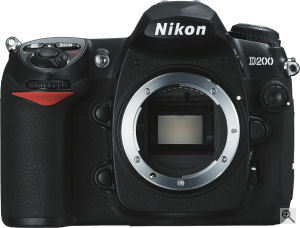 | | Type of Camera | Single-lens reflex digital camera | | Effective Pixels | 10.2 million | | Image Sensor | RGB CCD, 23.6 x 15.8mm; total pixels: 10.92 million | | Image Size (pixels) | 3,872 x 2,592 [L], 2,896 x 1,944 [M], 1,936 x 1,296 [S] | | ISO Sensitivity (Recommended Exposure Index) | 100 to 1600 in steps of 1/3, 1/2 or 1 EV with additional settings up to 1 EV over 1600 | | Storage Media | CompactFlash™ (CF) Card (Type I and II) and Microdrive™ | | Storage System | Compressed NEF (RAW): 12-bit compression, JPEG: JPEG baseline-compliant | | File System | Exif 2.21, Compliant DCF 2.0 and DPOF | | White Balance | Auto (TTL white balance with 1,005-pixel RGB sensor), six manual modes with fine-tuning, color temperature setting, preset white balance, white balance bracketing possible (2 to 9 frames in increments of 1, 2 or 3) | | LCD Monitor | 2.5-in., 230,000-dot, low-temperature polysilicon TFT LCD with brightness adjustment | Playback Function | 1) Full frame 2) Thumbnail (4 or 9 segments) 3) Zoom 4) Slideshow 5) RGB histogram indication 6) Shooting data 7) Highlight point display 8) Auto image rotation | | Delete Function | Card format, All photographs delete, Selected photographs delete | | Video Output | Can be selected from NTSC and PAL | | Interface | USB 2.0(Hi-speed) (mini-B connector); mass storage and PTP connectable; FTP file transfer and PTP/IP camera control/file transfer is also available with optional WT-3 (IEEE 802.11b/g); CF card slot Type II: supports firmware updates via CF cards | | Text Input | Up to 36 characters of alphanumeric text input available with LCD monitor and multi-selector; stored in Exif header | | Compatible Lenses | Nikon F mount (with AF coupling and AF contacts) | | Picture Angle | Equivalent in 35mm [135] format is approx. 1.5 times lens focal length | | Viewfinder | Fixed eye-level pentaprism; built-in diopter adjustment (-2.0 to +1.0m-1) | | Eyepoint | 19.5mm (-1.0m-1) | | Focusing Screen | Type-B BriteView Clear Matte screen Mark II with superimposed focus brackets and On-Demand grid lines | | Viewfinder Frame Coverage | Approx. 95% (vertical & horizontal) | | Viewfinder Magnification | Approx. 0.94x with 50mm lens at infinity; -1.0m-1 | | Viewfinder Information | Focus indications, Metering system, AE/FV lock indicator, Flash sync indicator, Shutter speed, Aperture value, Exposure/Exposure compensation indicator, ISO sensitivity, Exposure mode, Flash output level compensation, Exposure compensation, Number of remaining exposures | | Autofocus | TTL phase detection by Nikon Multi-CAM 1000 autofocus module with AF-assist illuminator (approx. 0.5m to 3.0m) Detection range: EV -1 to +19 (ISO 100 equivalent, at normal temperature: 20°C/68°F) | | Lens Servo | Instant single-servo AF (S); continuous-servo AF (C); manual (M); predictive focus tracking automatically activated according to subject status in continuous-servo AF | | Focus Area | Normal: 11 areas; single area or group can be selected; Wide: focus area can be selected from 7 areas | | AF Area Mode | 1) Single Area AF 2) Dynamic Area AF 3) Group Dynamic AF 4) Dynamic area AF with closest subject priority | | Focus Lock | Focus can be locked by pressing shutter-release button halfway (single-servo AF) or by pressing AE-L/AF-L button | | Exposure Metering System | Three-mode through-the-lens (TTL) exposure metering
1) 3D Color Matrix Metering II (type G and D lenses); color matrix metering II (other CPU lenses); color matrix metering available with non-CPU lenses if user provides lens data; metering performed by 1,005-segment RGB sensor
2) Center-weighted: Weight of 75% given to 6, 8, 10, or 13mm dia. circle in center of frame
3) Spot: Meters 3mm dia. circle (about 2.0% of frame) centered on active focus area (on center focus area when non-CPU lens is used) | | Exposure Metering Range (ISO 100, f/1.4 lens, 20°C/68°F) | 1) EV 0 to 20 (3D Color Matrix or center-weighted metering)
2) EV 2 to 20 (spot metering) | Exposure Meter Coupling | Combined CPU and AI | | Exposure Modes | Programmed Auto [P] with flexible program; Shutter-Priority Auto [S]; Aperture Priority Auto [A]; Manual [M] | | Exposure Compensation | ±5 EV in increments of 1/3, 1/2 or 1 EV | | Auto Exposure Lock | Luminosity locked at detected value with AE-L/AF-L button | | Auto Exposure Bracketing | 2 to 9 exposures in increments of 1, 2, or 3 | | Shooting Modes | 1) Single frame shooting mode 2) Continuous low speed (CL) shooting mode: 1-4 frames per second 3) Continuous high-speed shooting mode: 5 frames per second 4) Self-timer shooting mode 5) Mirror-up mode | | Shutter | Electronically-controlled vertical-travel focal plane shutter, 30 to 1/8000 sec. in steps of 1/3, 1/2 or 1 EV, bulb | | Sync Contact | X-contact only; flash synchronization at up to 1/250 sec. | | Flash Control | 1) TTL: TTL flash control by 1,005-pixel RGB sensor
Built-in Speedlight: i-TTL balanced fill-flash or standard i-TTL flash (spot metering or mode dial set to [M])
SB-800, SB-600 or SB-R200: i-TTL balanced fill-flash for digital SLR and standard i-TTL flash for digital SLR
2) Auto aperture: Available with SB-800 with CPU lens
3) Non-TTL Auto: Available with Speedlights such as SB-800, 80DX, 28DX, 28, 27, and 22s
4) Range-priority manual; available with SB-800 | | Flash Sync Mode | 1) Front-curtain Sync (normal sync), 2) Red-eye Reduction, 3) Red-eye Reduction with Slow Sync, 4) Slow Sync, 5) Rear-curtain Sync | | Built-in Flash | Manual pop-up with button release
Guide number (ISO 100 at m/ft and 20°C/68°F): approx. 12/39 (manual 13/42) | | Flash Compensation | -3 to +1 EV in increments of 1/3 or 1/2 EV | Accessory Shoe | Standard ISO hot-shoe contact with safety lock provided | | Sync Terminal | ISO 519 standard terminal | | Self-timer | Electronically controlled timer with 2 to 20 seconds duration | | Depth of Field Preview | When CPU lens is attached, lens aperture can be stopped down to value selected by user (A and M modes) or value selected by camera (P and S modes) | | Remote Control | Via 10-pin Remote Cord MC-30/36 (optional) or Wireless Remote Control WT-3 (optional) | | GPS | NMEA 0183 (Ver. 2.01) interface standard supported with 9-pin D-sub cable (optional) and GPS Adapter Cord MC-35 (optional) | | Power Source | One Rechargeable Li-ion Battery EN-EL3e, MB-D200 battery pack (optional) with one or two rechargeable Nikon EN-EL3e Li-ion batteries or six AA alkaline (LR6), NiMH (HR6), lithium (FR6) batteries, or ZR6 nickel-manganese AA batteries, AC Adapter EH-6 (optional) | | Tripod Socket | 1/4 in. (ISO 1222) | | Dimensions (W x H x D) | Approx. 147 x 113 x 74mm (5.8 x 4.4 x 2.9 in.) | | Weight | Approx. 830g (1 lbs 13 oz) without battery, memory card, body cap, or monitor cover | | Supplied Accessories* | Rechargeable Li-ion Battery EN-EL3e, Quick Charger MH-18a, Video Cable, USB Cable UC-E4, Strap, Body cap, Eyepiece Cap DK-5, Rubber Eyecup DK-21, LCD monitor cover BM-6, PictureProject CD-ROM | | Optional Accessories | Multi-Power Battery pack MB-D200, Wireless Transmitter WT-3, Semi-soft case D200, Magnifying Eyepiece DK-21M, Remote cord MC-36/30, GPS Adapter Cord MC-35, AC Adapter EH-6, Speedlight SB-800/SB-600/SB-R200, Nikon Capture 4 (Ver. 4.4) | | More Photos | 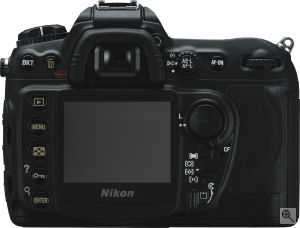 | 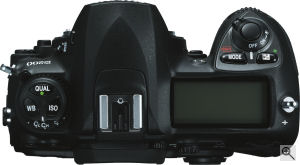 | 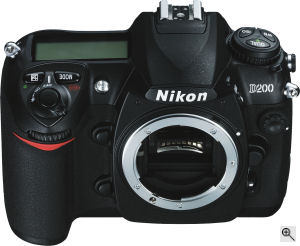 | 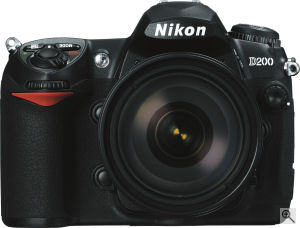 | 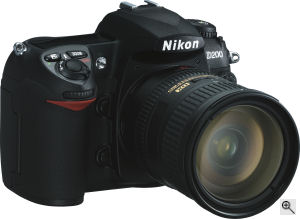 | 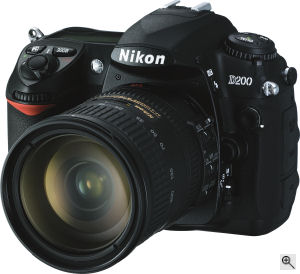 | 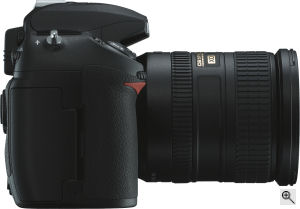 | 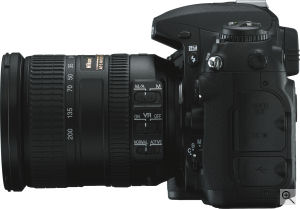 | 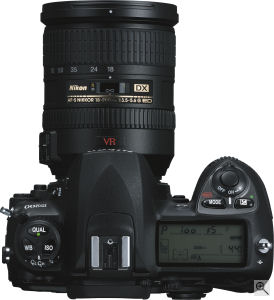 | 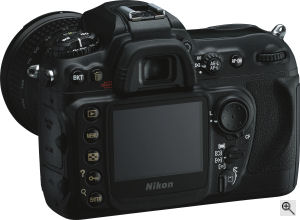 | 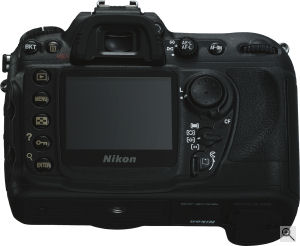 | 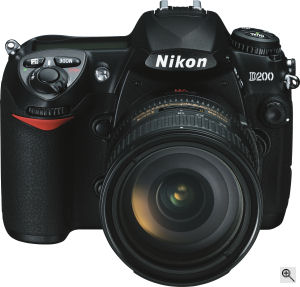 | 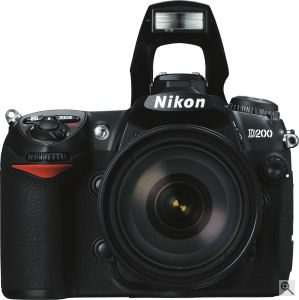 | 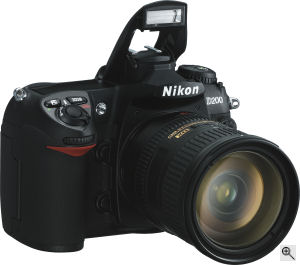 | 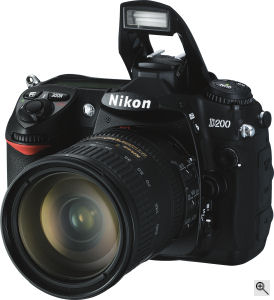 | 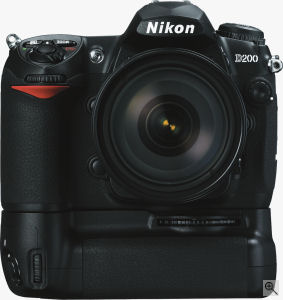 | 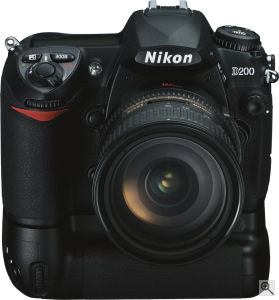 | 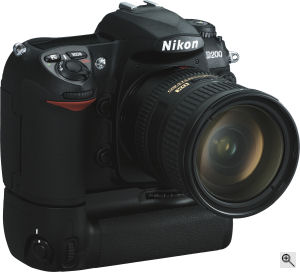 | 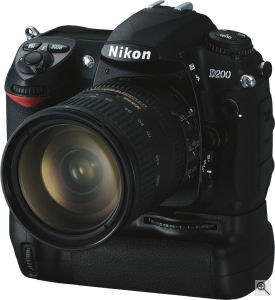 | 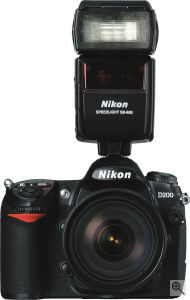 | 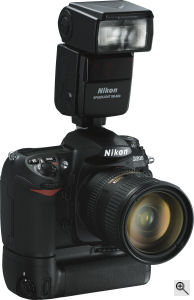 | 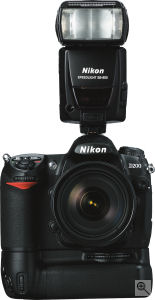 | 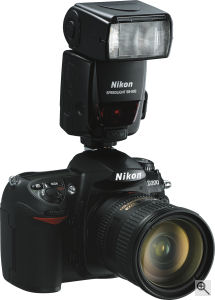 | 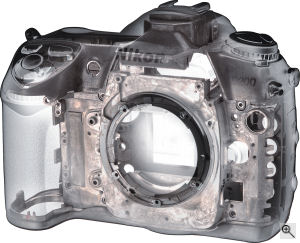 | 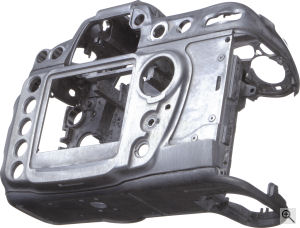 | 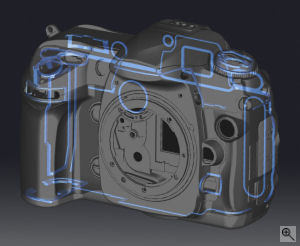
Weather Seals | 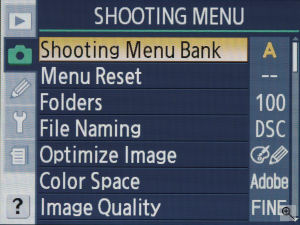 | 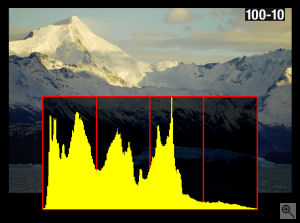 | 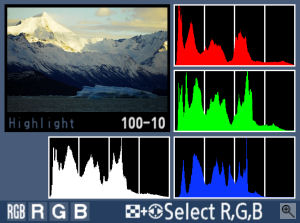 | 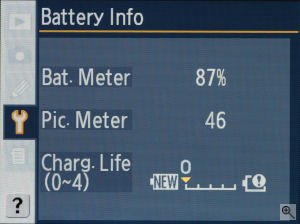 | 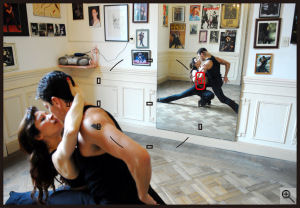
Autofocusing Points | 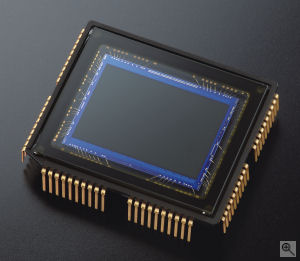
CCD Image Sensor | 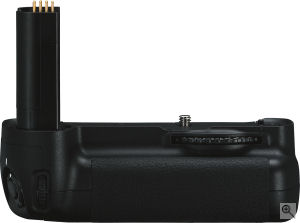 | 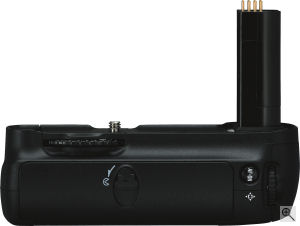 | 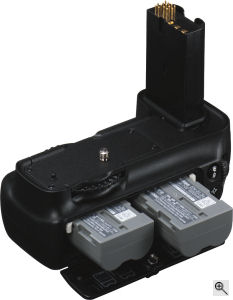 | 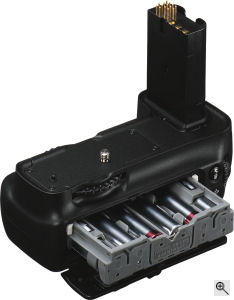 | 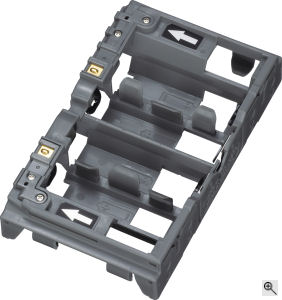
Battery Grip AA adapter | | . | Following is a comparison of the Nikon D200 with its closest rivals from competitors Konica Minolta and Pentax, based on pricing and feature-set (things have been rather hectic here lately, but if we can get a moment, we'll update this table to include Fujifilm's FinePix S2 Pro, which is now selling in the $1700 region): | Mid-Range SLR Camera Comparison | Manufacturer | Canon | Konica Minolta | Nikon | Pentax | | Model | EOS 20D | Maxxum 7D | D200 | *ist D | Imaging
System | Sensor Manufacturer | Canon | Sony | Unknown | Sony | | Sensor Type | CMOS | CCD | CCD | CCD | | Color Filter Array | RGB | RGB | RGB | RGB | | Total Megapixels | 8.25 | 6.3 | 10.92 | 6.31 | | Effective Megapixels | 8.5 | 6.1 | 10.2 | 6.1 | | Effective Sensor Size (mm) | 22.5 x 15.0 | 23.7 x 15.6 | 23.6 x 15.8 | 23.5 x 15.7 | | Focal Length Multiplier (approx.) | 1.6x | 1.5x | 1.5x | 1.5x | | Image Processor | DIGIC II | CxProcess III | Not stated | Not stated | | Viewfinder | Type | Eye-level pentaprism | Eye-level pentaprism | Eye-level pentaprism | Eye-level pentaprism | | Coverage | 95% | 95% | 95% | 95% | | Magnification (-1 diopter with 50mm lens at infinity) | 0.9x | 0.9x | 0.94x | 0.95x | | Eyepoint (mm) | 20 | 25 | 19.5 | Unknown | | Dioptric Adjustment Range (diopters) | -3.0 to +1.0 | -3.0 to +1.0 | -2.0 to +1.0 | -2.5 to +1.5 | | Focusing Screen | Fixed, precision matte screen | Spherical Acute Matte (G-type as standard) | B-type BriteView clear matte screen II, with superimposed focus brackets and on-demand grid lines | Natural-Bright-Matte focusing screen | | Viewfinder
Info Display | AF (AF points, focus confirmation light), exposure (shutter speed, aperture value, manual exposure, AE lock, exposure compensation amount, AEB level, partial metering area), flash (flash ready, red-eye reduction lamp on, high-speed sync, FE lock, flash exposure compensation amount), warnings (exposure warning, improper FE lock warning, CF card full warning, CF card error warning, no CF card warning, busy), maximum burst for continuous shooting, shots remaining | Wide focus frame, spot AF area, local focus areas, spot metering area, active focus point, anti-shake scale, flash compensation indicator, flash signal, high-speed sync indicator, wireless / remote flash indicator, manual focus indicator, AE lock indicator, focus signal, shutter-speed display, aperture display, EV scale, camera-shake warning, frames-remaining counter | Focus indications, Metering system, AE/FV lock indicator, Flash sync indicator, Shutter speed, Aperture value, Exposure/Exposure compensation indicator, ISO sensitivity, Exposure mode, Flash output level compensation, Exposure compensation, Number of remaining exposures | Out of image area: Built-in flash status, AF sensor pattern, in-focus, shutter speed, aperture, exposure compensation factor, bar graph. Within image area: AF frame with superimposed AF sensor point, spot AF frame. | | Depth of Field Preview | Enabled with depth-of-field preview button | Enabled with depth-of-field preview button | Enabled with depth-of-field preview button | Enabled with depth-of-field preview position on power switch | Recording
System | Recording Media / Quantity / Slot Type | Type I or II CF card / Microdrive | Type I or II CF card / Microdrive | Type I or II CF card / Microdrive | Type I or II CF card / Microdrive | | Compatible File System | FAT 16 / FAT 32 | FAT 16 / FAT 32 | Unknown | FAT 16 / FAT 32 | | Recording Formats | RAW (CR2), JPEG | RAW (MRW), JPEG | RAW (NEF), JPEG | RAW (PEF), JPEG, TIFF | | Maximum Resolution | 3504 x 2336 | 3008 x 2000 | 3872 x 2592 | 3008 x 2008 | | Reduced Resolutions (JPEG only) | 2544 x 1696; 1752 x 1168 | 2256 x 1496; 1504 x 1000 | 2896 x 1944; 1936 x 1296 | 2400 x 1600; 1536 x 1024 | | RAW + JPEG Recording | Yes, selectable JPEG resolution / compression | Yes, selectable JPEG resolution (fine compression only) | Yes, Selectable JPEG resolution / compression | No | Color Space &
White Balance | User-Selectable Color Space | Yes
sRGB + Adobe RGB | Yes
sRGB (two variants) + Adobe RGB | Unknown | Yes
sRGB + Adobe RGB | | Processing Parameters
(Contrast, Sharpness, Saturation, Color Tone) / # of Increments | 5 | 5 | Unknown | 3 options each for contrast, sharpness and saturation | | Preset WB settings | 6 (Daylight, Cloudy, Shade, Incandescent, Fluorescent, Flash) | 6 (Daylight, Shade, Cloudy, Tungsten, Fluorescent, Flash) | 6 (details unknown) | 11 (Auto, Daylight, Shade, Cloudy, Fluorescent [white, neutral, or daylight], Tungsten, and three Manual settings) | | Manual Color Temperature Setting Range | 2800 ~ 10000K in 100K increments | 2500 ~ 9900K in 100K increments | Color temperature setting available, details unknown | None | | WB Adjustment Range | ±3 steps in 1-step increments
5 mireds per step | ±3 steps in 1-step increments
Arbitrary step size (approx. 10 mireds per step in most modes) | Fine tuning possible, details unknown | Not available | Autofocus
System | Type | TTL-CT-SIR with a CMOS sensor
(TTL secondary image registration, phase detection) | TTL phase detection with CCD line sensors | TTL phase detection by Nikon Multi-CAM1000 autofocus module | TTL phase-matching by SAFOX VIII | | # of Focusing Points (Focusing Point Type) | 9 points, 1 cross type and 8 single-axis | 9 points, 8 lines with center cross-hair sensor | 7 or 11 points | 11 points | | Superimposed Focus Point Display | Yes | Yes | Yes | Yes | | AF Working Range | EV 0.5 ~ 18 | EV-1 ~ EV18 (ISO 100) | EV -1 ~ 19 (ISO 100) | EV0 to EV19 (ISO 200) | | AF-assist Beam | Yes, stroboscopic flash (Range: Approx. 4.0m / 13.1ft. at center, approx. 3.5m/11.5ft. off-center) | Yes, stroboscopic flash | Yes, illuminator range approx. 3.0 m / 9.8 ft | Yes, stroboscopic flash | Exposure
Control | Shooting Modes | 12 - Program AE (Full Auto, Portrait, Landscape, Close-up, Sports, Night Portrait, Flash Off, Program), shutter-priority AE, aperture-priority AE, depth-of-field AE, manual exposure, ETTL autoflash | 8 - Full Auto, Program, shutter-priority AE, aperture-priority AE, manual, three memory register settings | 4 - Program, shutter-priority AE, aperture-priority AE, manual mode. | 6 - Auto exposure with Hyper Program, Programmed AE, Shutter-Priority AE, Aperture-Priority AE, Metered Manual, bulb | | Metering Zones | 35 | 14 | 1,005 | 16 | | Metering Modes | Evaluative (linked to any AF point), center weighted, 9% partial | 14-segment honeycomb-pattern metering, Center-weighted, Spot | 1) 3D Color Matrix Metering II (type G and D lenses); color matrix metering II (other CPU lenses); color matrix metering available with non-CPU lenses if user provides lens data; metering performed by 1,005-segment RGB sensor
2) Center-weighted: Weight of 75% given to 6, 8, 10, or 13mm dia. circle in center of frame
3) Spot: Meters 3mm dia. circle (about 2.0% of frame) centered on active focus area (on center focus area when non-CPU lens is used) | Multi, Center-Weighted, and Spot | | Metering System Working Range | EV 1 ~ 20 | 1) EV 0 ~ 20 (14-segment honeycomb-pattern or center-weighted metering)
2) EV 3 ~ 20 (spot metering)
(ISO 100 equivalent, f/1.4 lens) | 1) EV 0 to 20 (3D Color Matrix or center-weighted metering)
2) EV 2 to 20 (spot metering) | 1) EV 0 ~ 21 (ISO200)
2) Multi-segment - EV 1 ~ 21.5 | | ISO Range / Extended | 100 ~ 1600 / 3200 | 100 ~ 1600 / 3200 | 100 ~ 1600 / 3200 | 200 ~ 1600 / 3200 | | Exposure Compensation | +/- 2EV in 1/2 or 1/3EV increments | +/- 3EV in 1/2EV increments, or +/- 2EV in 1/3EV increments | +/- 5EV in 1, 1/2 or 1/3EV increments | +/- 3EV in 1/2EV increments, or +/- 2EV in 1/3EV increments | | Automatic Exposure Bracketing | +/- 2EV in 1/2 or 1/3EV increments | +/- 2EV in 1/2 increments | 2 to 9 exposures in increments of 1, 2, or 3 | 3 shots in +/- 1/2, or 1/3 EV steps | Shutter Speeds,
Frame Rate, Shutter Lag | Shutter Type | Mechanical, all speeds electronically controlled | Mechanical | Mechanical Focal Plane, electronically controlled | Mechanical Focal Plane, electronically controlled | | Shutter Speed Range | 1/8000 ~ 30 sec. (1/2 or 1/3EV increments) and bulb | 1/4000 ~ 30 sec. in steps of 1/3 or 1/2 EV, bulb | 1/8000 ~ 30 sec. in steps of 1/3, 1/2 or 1 EV, bulb | 1/4000 ~ 30 sec. (1/2EV increments) and bulb | | Maximum Frames Per Second / Buffer depth | 5 fps / 23 frames | 2.75 fps / 15 frames | 5 fps / 37 JPEG or 22 RAW frames (manufacturer spec) | 2.6 fps / 6 frames | | Flash | Built-in Flash / Guide Number at ISO 100. | Yes (13 meters / 43 feet) | Yes (12 meters / 39 feet) | Yes (12 meters / 39 feet) | Yes (11 meters / 36 feet) | | Max flash x-sync speed. (sec.) | 1/250 | 1/160 (anti-shake off) / 1/125 (anti-shake on) | 1/250 | 1/150 | | Flash Exposure Compensation | +/- 2EV in 1/2 or 1/3EV increments | +/- 2EV in 1/2EV increments | -3 to +1 EV, 1/3 or 1/2 EV steps | -3 to +1 EV, 1/2 EV steps | | Slow-sync flash | 1st or 2nd curtain | 1st or 2nd curtain | 1st or 2nd curtain | 1st or 2nd curtain | | PC Sync Terminal | Yes | Hot shoe only | Yes | Hot shoe only | Playback
System | LCD Size / Pixel Count | 1.8 in. LCD / 118,000 pixels | 2.5 in LCD / 207,000 pixels | 2.5 in LCD / 230,000 pixels | 1.8 in LCD / 118,000 pixels | | Enlarged Playback / Scroll | 1.5~10x in 15 steps / Yes | 4.7x max / Yes | Zoom and scroll possible, details unknown | Up to 12x / Yes | | LCD Monitor Brightness Adjustment Range | 5 steps | 11 steps | Yes, details unknown | 15 steps | | Automatic Rotation for Vertical Shots | Yes | Yes | Yes | No | | Other Features | Computer Connection | Yes, USB 2.0, PTP-compliant | Yes, PTP-compliant (v2.0 standard, v2.0 speed) | Yes, PTP-compliant (v2.0 standard, v2.0 speed) | Yes, USB v1.1 | | Direct Printing (PictBridge-compliant printers) | Yes | Yes | Details unknown | No | | Menu Languages | 12 (English, German, French, Dutch, Danish, Finnish, Italian, Norwegian, Swedish, Spanish, Simplified Chinese, and Japanese.) | 8 (English, German, French, Spanish, Italian, Swedish, Simplified Chinese, and Japanese.) | Details unknown | 6 (English, French, German, Spanish, Italian, Japanese) | | Camera Default Reset | Yes | Yes | Details unknown | Yes | | Custom Functions (Quantity / Settings) | Yes (17 / 61) | Yes (20 / 44) | Yes (details unknown) | Yes (22 / 53) | | Remote Control | N3-type remote control | Optional, compatible with RC-1000S or RC-1000L | Yes, 10-pin remote terminal for optional MC-30/36 remote cords or WT-3 wireless remote | Optional IR | | Info LCD Panel / Illumination | Yes / Yes (dedicated button) | No / N/A | Yes / details unknown | Yes / Yes | | Ultrasonic CCD dust-removal function | No | No | No | No | | Body Structure | Body Cover / Chassis | Magnesium Alloy / Stainless Steel | Magnesium Alloy (front) / Plastic (rear) | Largely Magnesium Alloy / Plastic | Largely plastic / Stainless Steel frame | | Power System | Battery Compatibility | Main: BP-511 / BP-512
Backup: CR2025 | NP-400 | EN-EL3e | 2 x CR-V3 or 4 x AA | | Rated Shooting Capacity at 20C/68F | 100% AE: 650
50% Flash: 500 | 100% AE: 600
50% Flash: 400 | Up to 1800 shots (manufacturer spec, conditions unknown) | No flash : 1000 | | Dimensions & Weight | Dimensions (WxHxD, mm) | 144 x 105.5 x 71.5 | 150 x 106 x 77.5 | 147 x 113 x 74 | 129 x 94.5 x 60 | | Weight (body only) | 685 g | 760 g | 830 g | 550 g | Operational
Environment | Operating Temperature Range | 0 ~ 40°C | 0 ~ 40°C | Not Stated | Not stated | | Operating Humidity Range | 85% max. | Not Stated | Not Stated | Not stated | | Kit Lens | Focal length/aperture | - | - | - | - | | Lens Compatibility | Lens Mount / Compatibility | EF / All EOS lenses, plus EF-S lenses | A-type / All A-type lenses except MD and MC series manual focus lenses. AF Macro 3x - 1x f/1.7-2.8 lens cannot be used with Anti-Shake, nor does Anti-Shake work with any lens with a macro release. | Details unknown | KAF / compatible with PENTAX KAF2-, KAF- and KA-mount lenses.
Power zoom function not available.
K-mount lenses usable with restrictions.
S-mount lenses usable with adapter and restrictions.
67/645 lenses usable adapter and restrictions. |
And following is a comparison of the Nikon D200 with Nikon's own existing digital SLR lineup in the under-$2000 price bracket:
| Nikon Digital SLR Camera Comparison | Manufacturer | Nikon | Nikon | Nikon | Nikon | Nikon | | Model | D50 | D70 | D70s | D100 | D200 | Imaging
System | Sensor Manufacturer | Sony | Sony | Sony | Sony | Unknown | | Sensor Type | CCD | CCD | CCD | CCD | CCD | | Color Filter Array | RGB | RGB | RGB | RGB | RGB | | Total Megapixels | 6.24 | 6.24 | 6.24 | 6.31 | 10.92 | | Effective Megapixels | 6.1 | 6.1 | 6.1 | 6.1 | 10.2 | | Effective Sensor Size (mm) | 23.7 x 15.6 | 23.7 x 15.6 | 23.7 x 15.6 | 23.7 x 15.6 | 23.6 x 15.8 | | Focal Length Multiplier (approx.) | 1.5x | 1.5x | 1.5x | 1.5x | 1.5x | | Image Processor | Not stated | Not stated | Not stated | Not stated | Not stated | | Viewfinder | Type | Eye-level pentamirror | Eye-level pentamirror | Eye-level pentamirror | Eye-level pentaprism | Eye-level pentaprism | | Coverage | 95% | 95% | 95% | 95% | 95% | | Magnification (-1 diopter with 50mm lens at infinity) | 0.75x | 0.75x | 0.75x | 0.8x | 0.94x | | Eyepoint (mm) | 18 | 18 | 18 | 20 | 19.5 | | Dioptric Adjustment Range (diopters) | -1.6 to +0.5 | -1.6 to +1.5 | -1.6 to +1.5 | -2.0 to +1.0 | -2.0 to +1.0 | | Focusing Screen | B-type BriteView clear matte Mark V, with superimposed focus brackets. | B-type BriteView clear matte screen II, with on-demand grid lines | B-type BriteView clear matte screen II, with on-demand grid lines | B-type BriteView clear matte screen II, with on-demand grid lines | B-type BriteView clear matte screen II, with superimposed focus brackets and on-demand grid lines | | Viewfinder
Info Display | AF information (AF points, focus confirmtation, AF area mode, AE/AF lock indicator), exposure information (shutter speed, aperture value, manual exposure, AE/AF lock indicator, exposure level, flash exposure, exposure compensation indicator, pre-set white balance recording indicator), flash-ready indicator, shots remaining, battery level, PC mode indicator | AF information (AF points, focus confirmation, AF area mode, AE/AF lock indicator), exposure information (shutter speed, aperture value, manual exposure, AE/AF lock indicator, exposure level, flash exposure, exposure compensation indicator), flash-ready indicator, shots remaining, battery level | AF information (AF points, focus confirmation, AF area mode, AE/AF lock indicator), exposure information (shutter speed, aperture value, manual exposure, AE/AF lock indicator, exposure level, flash exposure, exposure compensation indicator), flash-ready indicator, shots remaining, battery level | AF information (AF points, focus confirmation, AF area mode, AE/AF lock indicator), exposure information (shutter speed, aperture value, manual exposure, AE/AF lock indicator, exposure level, flash exposure, exposure compensation indicator), flash-ready indicator, shots remaining, battery level | Focus indications, Metering system, AE/FV lock indicator, Flash sync indicator, Shutter speed, Aperture value, Exposure/Exposure compensation indicator, ISO sensitivity, Exposure mode, Flash output level compensation, Exposure compensation, Number of remaining exposures | | Depth of Field Preview | Not available | Enabled with depth-of-field preview button | Enabled with depth-of-field preview button | Enabled with depth-of-field preview button | Enabled with depth-of-field preview button | Recording
System | Recording Media / Quantity / Slot Type | Secure Digital card | Type I or II CF card / Microdrive | Type I or II CF card / Microdrive | Type I or II CF card / Microdrive | Type I or II CF card / Microdrive | | Compatible File System | FAT 16 / FAT 32 | FAT 16 / FAT 32 | FAT 16 / FAT 32 | FAT 16 / FAT 32 | Unknown | | Recording Formats | RAW (NEF), JPEG | RAW (NEF), JPEG | RAW (NEF), JPEG | RAW (NEF), JPEG | RAW (NEF), JPEG | | Maximum Resolution | 3008 x 2000 | 3008 x 2000 | 3008 x 2000 | 3008 x 2000 | 3872 x 2592 | | Reduced Resolutions (JPEG only) | 2256 x 1496; 1504 x 1000 | 2240 x 1488; 1504 x 1000 | 2240 x 1488; 1504 x 1000 | 2240 x 1488; 1504 x 1000 | 2896 x 1944; 1936 x 1296 | | RAW + JPEG Recording | Yes, basic JPEG only | Yes, basic JPEG only | Yes, basic JPEG only | No | Yes, Selectable JPEG resolution / compression | Color Space &
White Balance | User-Selectable Color Space | Yes
sRGB (two variants) + Adobe RGB | Yes
sRGB (two variants) + Adobe RGB | Yes
sRGB (two variants) + Adobe RGB | Yes
sRGB (two variants) + Adobe RGB | Unknown | | Processing Parameters
(Contrast, Sharpness, Saturation, Color Tone) / # of Increments | 6 options each for sharpness and contrast, 3 options for saturation. 7-step hue adjustment. Digital vari-programs preset various processing parameters as well, and color space III boosts saturation somewhat, particularly in greens. | 6 options each for sharpness and contrast, 3 options for saturation. 7-step hue adjustment. Digital vari-programs preset various processing parameters as well, and color space III boosts saturation somewhat, particularly in greens. | 6 options each for sharpness and contrast, 3 options for saturation. 7-step hue adjustment. Digital vari-programs preset various processing parameters as well, and color space III boosts saturation somewhat, particularly in greens. | 5 options for sharpening, 6 for contrast, 7 for hue, none for saturation. Second sRGB color space boosts saturation somewhat. | Unknown | | Preset WB settings | 6 (Daylight, Cloudy, Shade, Incandescent, Fluorescent, Flash) | 6 (Daylight, Cloudy, Shade, Incandescent, Fluorescent, Flash) | 6 (Daylight, Cloudy, Shade, Incandescent, Fluorescent, Flash) | 6 (Daylight, Cloudy, Shade, Incandescent, Fluorescent, Flash) | 6 (details unknown) | | Manual Color Temperature Setting Range | (No Kelvin option, but very broad Preset WB range) | (No Kelvin option, but very broad Preset WB range) | (No Kelvin option, but very broad Preset WB range) | (No Kelvin option, but very broad Preset WB range) | Color temperature setting available, details unknown | | WB Adjustment Range | Not available | ±3 steps in 1-step increments
10 mireds per step | ±3 steps in 1-step increments
10 mireds per step | ±3 steps in 1-step increments
10 mireds per step | Fine tuning possible, details unknown | Autofocus
System | Type | TTL phase detection by Nikon Multi-CAM900 autofocus module | TTL phase detection by Nikon Multi-CAM900 autofocus module | TTL phase detection by Nikon Multi-CAM900 autofocus module | TTL phase detection by Nikon Multi-CAM900 autofocus module | TTL phase detection by Nikon Multi-CAM1000 autofocus module | | # of Focusing Points (Focusing Point Type) | 5 points | 5 points | 5 points | 5 points | 7 or 11 points | | Superimposed Focus Point Display | Yes | Yes | Yes | Yes | Yes | | AF Working Range | EV -1 ~ 19 (ISO 100) | EV -1 ~ 19 (ISO 100) | EV -1 ~ 19 (ISO 100) | EV -1 ~ 19 (ISO 100) | EV -1 ~ 19 (ISO 100) | | AF-assist Beam | Bright incandescent lamp, (Range approx. 3.0 m / 9.8 ft, depending on lens.) Not dependent on flash setting. | Bright incandescent lamp, (Range approx. 3.0 m / 9.8 ft, depending on lens.) Not dependent on flash setting. | Bright incandescent lamp, (Range approx. 3.0 m / 9.8 ft, depending on lens.) Not dependent on flash setting. | Bright incandescent lamp, (Range approx. 3.0 m / 9.8 ft, depending on lens.) Not dependent on flash setting. | Yes, illuminator range approx. 3.0 m / 9.8 ft | Exposure
Control | Shooting Modes | 11 - Program, shutter-priority AE, aperture-priority AE, Manual, Auto, Portrait, Landcape, Close up, Sports, Child, Night Portrait. | 11 - Program, shutter-priority AE, aperture-priority AE, Manual, Auto, Portrait, Landcape, Close up, Sports, Night Landscape, Night Portrait. | 11 - Program, shutter-priority AE, aperture-priority AE, Manual, Auto, Portrait, Landcape, Close up, Sports, Night Landscape, Night Portrait. | 4 - Program, shutter-priority AE, aperture-priority AE, manual mode. | 4 - Program, shutter-priority AE, aperture-priority AE, manual mode. | | Metering Zones | 420 | 1,005 | 1,005 | 10 | 1,005 | | Metering Modes | 1) 3D color matrix metering with 420-segment RGB sensor.
(2) Center-weighted: Weight of 75% (8mm dia. circle) in center of frame, or weighting based on average of entire frame.
(3) Spot: Meters 2.3 mm dia. circle (about one percent of frame) centered on active focus area. | 1) 3D color matrix metering with 1,005-pixel RGB sensor
(2) Center-weighted: Weight of 75% (8mm dia. circle) given to 6, 8, 10, or 13 mm dia. circle in center of frame, or weighting based on average of entire frame
(3) Spot: Meters 2.3 mm dia. circle (about 1% of frame) centered on active focus area | 1) 3D color matrix metering with 1,005-pixel RGB sensor
(2) Center-weighted: Weight of 75% (8mm dia. circle) given to 6, 8, 10, or 13 mm dia. circle in center of frame, or weighting based on average of entire frame
(3) Spot: Meters 2.3 mm dia. circle (about 1% of frame) centered on active focus area | 1) 3D Matrix Metering with 10-segment SPD,
2) Center-Weighted,
3) Spot Metering | 1) 3D Color Matrix Metering II (type G and D lenses); color matrix metering II (other CPU lenses); color matrix metering available with non-CPU lenses if user provides lens data; metering performed by 1,005-segment RGB sensor
2) Center-weighted: Weight of 75% given to 6, 8, 10, or 13mm dia. circle in center of frame
3) Spot: Meters 3mm dia. circle (about 2.0% of frame) centered on active focus area (on center focus area when non-CPU lens is used) | | Metering System Working Range | 1) EV 0 ~ 20 (3D color matrix or center-weighted metering)
2) EV 2 ~ 20 (spot metering)
(ISO 100 equivalent, f/1.4 lens, 20°C/68°F) | 1) EV 0 ~ 20 (3D color matrix or center-weighted metering)
2) EV 2 ~ 20 (spot metering)
(ISO 100 equivalent, f/1.4 lens, 20°C/68°F) | 1) EV 0 ~ 20 (3D color matrix or center-weighted metering)
2) EV 2 ~ 20 (spot metering)
(ISO 100 equivalent, f/1.4 lens, 20°C/68°F) | 1) Matrix Metering: EV 0 ~ 21;
2) Center-Weighted Metering: EV 0 ~ 21;
3) Spot Metering: EV 3 ~21 (at normal temperature, ISO 100 equivalent, f/1.4 lens) | 1) EV 0 to 20 (3D Color Matrix or center-weighted metering)
2) EV 2 to 20 (spot metering) | | ISO Range / Extended | 200 ~ 1600 / -- | 200 ~ 1600 / -- | 200 ~ 1600 / -- | 200 ~ 1600 / 3200 | 100 ~ 1600 / 3200 | | Exposure Compensation | +/- 5EV in 1/2 or 1/3EV increments | +/- 5EV in 1/2 or 1/3EV increments | +/- 5EV in 1/2 or 1/3EV increments | +/- 5EV in 1/2 or 1/3EV increments | +/- 5EV in 1, 1/2 or 1/3EV increments | | Automatic Exposure Bracketing | 3 shots, 1/3, 1/2, 2/3 or 1 EV steps | 2 or 3 shots, 1/3, 1/2, 2/3 or 1 EV steps | 2 or 3 shots, 1/3, 1/2, 2/3 or 1 EV steps | 2 or 3 shots, 1/3, 1/2, 2/3 or 1 EV steps | 2 to 9 exposures in increments of 1, 2, or 3 | Shutter Speeds,
Frame Rate, Shutter Lag | Shutter Type | Combined mechanical and CCD electronic shutter | Combined mechanical and CCD electronic shutter | Combined mechanical and CCD electronic shutter | Mechanical | Mechanical Focal Plane, electronically controlled | | Shutter Speed Range | 1/4000 ~ 30 sec. in steps of 1/3 or 1/2 EV, bulb | 1/8000 ~ 30 sec. in steps of 1/3 or 1/2 EV, bulb | 1/8000 ~ 30 sec. in steps of 1/3 or 1/2 EV, bulb | 1/4000 ~ 30 sec. and Bulb | 1/8000 ~ 30 sec. in steps of 1/3, 1/2 or 1 EV, bulb | | Maximum Frames Per Second / Buffer depth | (Not tested yet)
(Prototype sample) | 2.92 fps / unlimited (In JPEG large/normal, with fast card) | 3 fps (manufacturer spec) / burst depth unknown | 2.88 fps / 9 frames | 5 fps / 37 JPEG or 22 RAW frames (manufacturer spec) | | Flash | Built-in Flash / Guide Number at ISO 100. | Yes (11 meters / 36 feet) | Yes (11 meters / 36 feet) | Yes (11 meters / 36 feet) | Yes (11 meters / 36 feet) | Yes (12 meters / 39 feet) | | Max flash x-sync speed. (sec.) | 1/500 (!) | 1/500 (!) | 1/500 (!) | 1/180 | 1/250 | | Flash Exposure Compensation | -3 to +1 EV, 1/3 or 1/2 EV steps | -3 to +1 EV, 1/3 or 1/2 EV steps | -3 to +1 EV, 1/3 or 1/2 EV steps | -3 to +1 EV, 1/3 or 1/2 EV steps | -3 to +1 EV, 1/3 or 1/2 EV steps | | Slow-sync flash | 1st or 2nd curtain | 1st or 2nd curtain | 1st or 2nd curtain | 1st or 2nd curtain | 1st or 2nd curtain | | PC Sync Terminal | Hot shoe only | Hot shoe only | Hot shoe only | Hot shoe only | Yes | Playback
System | LCD Size / Pixel Count | 2.0 in LCD / 130,000 pixels | 1.8 in LCD / 130,000 pixels | 2.0 in LCD / 130,000 pixels | 1.8 in LCD / 118,000 pixels | 2.5 in LCD / 230,000 pixels | | Enlarged Playback / Scroll | 1.1 - 4x in 10 steps / Yes | 1.1 - 4x in 10 steps / Yes | 1.1 - 4x in 10 steps / Yes | 1.1 - 4x in 10 steps / Yes | Zoom and scroll possible, details unknown | | LCD Monitor Brightness Adjustment Range | 5 steps | 5 steps | 5 steps | 5 steps | Yes, details unknown | | Automatic Rotation for Vertical Shots | Yes | Yes | Yes | No | Yes | | Other Features | Computer Connection | Yes, PTP-compliant (v2.0 standard, v2.0 speed) | Yes, PTP-compliant (v2.0 standard, v1.1 speed) | Yes, PTP-compliant (v2.0 standard, v1.1 speed) | Yes, USB 1.1 | Yes, PTP-compliant (v2.0 standard, v2.0 speed) | | Direct Printing (PictBridge-compliant printers) | Yes | Yes | Yes | No | Details unknown | | Menu Languages | 13 (Japanese, German, English, Spanish, French, Portuguese, Russian, Korean, Italian, Traditional Chinese, Simplified Chinese, Dutch, Swedish) | 11 (Japanese, German, English, Spanish, French, Korean (?), Italian, Simplified Chinese, Dutch, Swedish) | 11 (Japanese, German, English, Spanish, French, Korean (?), Italian, Simplified Chinese, Dutch, Swedish) | 11 (Japanese, German, English, Spanish, French, Korean (?), Italian, Simplified Chinese, Dutch, Swedish) | Details unknown | | Camera Default Reset | Yes | Yes | Yes | Yes | Details unknown | | Custom Functions (Quantity / Settings) | Yes (6 / 20) | Yes (9 / 25) | Yes (9 / 25) | Yes (24) | Yes (details unknown) | | Remote Control | Optional IR | Optional IR | Optional, compatible with MC-DC1 or ML-L3 | Optional, 10-pin remote terminal available in optional Multi Function Battery Pack | Yes, 10-pin remote terminal for optional MC-30/36 remote cords or WT-3 wireless remote | | Info LCD Panel / Illumination | Yes / Yes (dedicated button) | Yes / Yes (dedicated button) | Yes / Yes (dedicated button) | Yes / Yes (dedicated button) | Yes / details unknown | | Ultrasonic CCD dust-removal function | No | No | No | No | No | | Body Structure | Body Cover / Chassis | Largely Plastic | Largely Plastic | Largely Plastic | Metal | Largely Magnesium Alloy / Plastic | | Power System | Battery Compatibility | EN-EL3,
EN-EL3a
(Ships with EN-EL3a, 1500 mAh vs 1400 mAh for EN-EL3)
CR2 pack is an added-cost accessory | EN-EL3,
CR2 pack
(3 cells) | EN-EL3,
EN-EL3a
(Ships with EN-EL3a, 1500 mAh vs 1400 mAh for EN-EL3)
CR2 pack is an added-cost accessory | EN-EL3 | EN-EL3e | | Rated Shooting Capacity at 20C/68F | | 100% AE: 2000
50% Flash: 400 | | 100% AE: 500 | Up to 1800 shots (manufacturer spec, conditions unknown) | | Dimensions & Weight | Dimensions (WxHxD, mm) | 133 x 102 x 76 | 140 x 111 x 78 | 140 x 111 x 78 | 144 x 116 x 80.5 | 147 x 113 x 74 | | Weight (body only) | 540 g | 595 g | 600 g | 700 g | 830 g | Operational
Environment | Operating Temperature Range | Not Stated | Not Stated | Not Stated | Not Stated | Not Stated | | Operating Humidity Range | Not Stated | Not Stated | Not Stated | Not Stated | Not Stated | | Kit Lens | Focal length/aperture | 18-55mm
f/3.5-4.5G | 18-70mm
f/3.5-4.5G ED | 18-70mm
f/3.5-4.5G ED | - | - | | Lens Compatibility | Lens Mount / Compatibility | - DX Nikkor: All functions supported;
- Type G- or D-AF Nikkor: All functions supported;
- Micro Nikkor 85mm F2.8D: All functions supported except some exposure modes;
- Other AF Nikkor (excluding lenses for F3AF): All functions supported except 3D Color Matrix Metering, i-TTL balanced Fill-Flash for digital SLR;
- AI-P Nikkor: All functions supported except 3D Color Matrix Metering, i-TTL balanced Fill-Flash for digital SLR and autofocus;
- Non-CPU: Can be used in exposure mode M, but exposure meter does not function; electronic range finder can be used if maximum aperture is f/5.6 or faster.
- IX Nikkor Lenses cannot be used.
| - DX Nikkor: All functions supported;
- Type G- or D-AF Nikkor: All functions supported;
- Micro Nikkor 85mm F2.8D: All functions supported except some exposure modes;
- Other AF Nikkor (excluding lenses for F3AF): All functions supported except 3D Color Matrix Metering, i-TTL balanced Fill-Flash for digital SLR;
- AI-P Nikkor: All functions supported except 3D Color Matrix Metering, i-TTL balanced Fill-Flash for digital SLR and autofocus;
- Non-CPU: Can be used in exposure mode M, but exposure meter does not function; electronic range finder can be used if maximum aperture is f/5.6 or faster.
- IX Nikkor Lenses cannot be used.
| - DX Nikkor: All functions supported;
- Type G- or D-AF Nikkor: All functions supported;
- Micro Nikkor 85mm F2.8D: All functions supported except some exposure modes;
- Other AF Nikkor (excluding lenses for F3AF): All functions supported except 3D Color Matrix Metering, i-TTL balanced Fill-Flash for digital SLR;
- AI-P Nikkor: All functions supported except 3D Color Matrix Metering, i-TTL balanced Fill-Flash for digital SLR and autofocus;
- Non-CPU: Can be used in exposure mode M, but exposure meter does not function; electronic range finder can be used if maximum aperture is f/5.6 or faster.
- IX Nikkor Lenses cannot be used.
| - DX Nikkor: All functions supported;
- Type G- or D-AF Nikkor: All functions supported;
- Micro Nikkor 85mm F2.8D: All functions supported except some exposure modes;
- Other AF Nikkor (excluding lenses for F3AF): All functions supported except 3D Color Matrix Metering, i-TTL balanced Fill-Flash for digital SLR;
- AI-P Nikkor: All functions supported except 3D Color Matrix Metering, i-TTL balanced Fill-Flash for digital SLR and autofocus;
- Non-CPU: Can be used in exposure mode M, but exposure meter does not function; electronic range finder can be used if maximum aperture is f/5.6 or faster.
- IX Nikkor Lenses cannot be used.
| Details unknown |
|
Original Source Press Release:
| NIKON® UNVEILS THE NEW D200™ DIGITAL SLR CAMERA 10.2 Megapixel D200 Digital SLR Delivers Outstanding Image Quality with Blazing Speed, Rugged Construction and Intelligent Features MELVILLE, NY (November 1, 2005) – Nikon (www.nikondigital.com) today introduced the highly anticipated new D200 – a precision-engineered, high performance digital SLR camera designed to satisfy the requirements of passionate and demanding photographers. Combining brand new technologies with advanced features inherited from Nikon’s venerable D2X professional digital SLR camera, the D200 incorporates more must-have features than any other camera in its class, enabling photographers to capture images in a way once reserved only for professionals. The D200 promises an extremely satisfying shooting experience, with a winning combination of quality, performance, construction and advanced system features. Employing a newly developed 10.2 effective megapixel Nikon DX Format CCD image sensor, the D200 captures images with remarkable resolution and clarity. Its sophisticated 1005-pixel 3D Color Matrix Metering II system ensures ideal exposures while an advanced Nikon image processing engine renders images with superb clarity and smooth color gradations. The D200 reacts with lighting speed, powering-up in a mere 0.15 seconds, and firing in an imperceptible 50 millisecond shutter release lag time. It can shoot five frames per second with a drastically shortened viewfinder blackout time of just 105 milliseconds between shots. Its large, bright viewfinder offers 0.94x magnification for comfortable and precise composition while a new 2.5 inch LCD screen provides ultra-wide 170 degrees viewing angle from all directions. With an all new 11-area Autofocus system, robust control of Nikon’s i-TTL Creative Lighting System and advanced Wi-Fi image-transmission options*, the D200 is a perfect fit for discriminating photographers and a natural choice for wedding, event and action photographers. “Nikon has spent considerable time and effort to truly understand the qualities and features photographers desire in an advanced digital SLR camera. The D200 embodies this research and delivers a camera that’s built to the requirements of passionate photographers, and meets demands for resolution, speed, precision, and ultimate image quality. The D200 represents an unmatched combination of quality, performance and value that’s hard to resist,” said Edward Fasano, general manager for Marketing, SLR Systems Products, at Nikon Inc. “The D200 is hands-down the most capable digital SLR camera in its category.” SMARTER…
The D200 embodies a host of intelligent technologies that deliver remarkably precise control and accurate automatic features. Equipped with Nikon’s exclusive 1,005 pixel 3D Color Matrix Metering II, the D200 seamlessly determines ideal exposures even in complex lighting conditions. Capturing scene elements including brightness, contrast and color content with a unique 1,005-pixel RGB-enabled sensor, this advanced system employs further improved algorithms for even better evaluation of large area highlight and shadow detail. The 3D Color Matrix Metering II light metering system also uses an onboard database of detailed exposure information from over 30,000 actual images against which instantaneous real-time comparisons are made as part of determining exposures. Rather than merely looking at light levels, a complex, yet transparent evaluation of overall scene content takes place, ensuring highly accurate exposures, even in challenging lighting conditions. The 10.2 effective megapixel image sensor on the D200 incorporates a high-speed 4-channel data output and a new Optical Low Pass Filter that significantly reduces any incidence of moiré as well as color fringing and shifting. Furthermore, 4-channel output allows the D200 to inherit the advanced image-processing engine of the Nikon D2x professional digital SLR that combines color-independent preconditioning prior to A/D conversion with advanced digital image processing algorithms to deliver fine color gradations with smooth, consistent transitions. Photographers can take advantage of the D200’s advanced image optimizing functionality that allows them to fine tune image characteristics such as sharpness, tone, color, saturation, and hue. Photographers can also select from preset options like Normal, Softer, Vivid, More Vivid, Portrait and Black-and-White. One of the most notable new features of the D200 is its all new 11-area AF system, convertible to a 7-wide area AF system, both based on Nikon’s advanced Multi-Cam 1000 AF Sensor Module. Not only does this AF system support the photographer with fast and precise auto focus under a variety of shooting conditions, but it also offers a pleasing array of functions for greater flexibility – allowing an individual area to be selected from either the 11-area AF or 7-wide area AF sensors for Single AF or making use of multiple sensors to enable Dynamic AF, Closest Subject Priority Dynamic AF and Group Dynamic AF. Running out of power on the D200 is harder than ever, since in addition to its remarkable capacity of up to 1800 shots per charge, the D200 also features an intelligent power management Fuel Gauge feature that constantly monitors the battery’s precise remaining power in 1% increments. It also displays the total number of shots taken on each charge as well as overall life of the battery, so photographers can easily tell when to replace a battery. The D200 is a wireless whiz, and features Nikon’s advanced i-TTL wireless Speedlight control built right into the camera, as well as wireless image transfer over a 802.11b/g Wi-Fi network built into the optional WT-3 Wireless Transmitter (available Spring 2006). The camera’s powerful built-in Speedlight, capable of coverage for lenses as wide as 18mm, features a Commander Mode that can wirelessly control up to two separate groups of an unlimited number of i-TTL speedlights such as the SB-800, SB-600 or SB-R200. The Commander Mode in the D200 can adjust flash compensation settings for each of the two groups on the fly, making light output control from speedlights placed in hard to reach locations simple and effortless. FASTER…
The D200 is faster than any other camera in its class, making its handling exceptionally responsive. The D200 can shoot continuously at up to five frames per second, capturing up to an impressive 37 JPEG images** or up to 22 NEF (RAW) images, making it ideal for action, wedding and event photography. Featuring an industry leading power-up time of 0.15 seconds, the D200 is ready to shoot when the photographer is ready. Its reduced shutter release time lag of 50 milliseconds is nearly undetectable and when shooting in its continuous burst mode of five frames per second, its shortened viewfinder blackout time (between each successive shot) of just 105 milliseconds proves especially useful in keeping an eye on a moving subject. STRONGER…
The D200 is designed with long term durability, ruggedness and precision in mind. Built on a magnesium alloy chassis and body cover, the D200 combines light weight with high-level durability and protects performance integrity. It also features an enhanced environmental sealing system that helps protect exterior seams from potentially damaging moisture and dust. The D200’s double-bladed shutter unit is tested to well over 100,000 cycles, ensuring highly reliable performance year after year. The shutter unit also employs a refined mirror balance mechanism that allows the mirror to complete its motion cycle and reach a complete stop with virtually no image degrading mirror bounce. The Ultimate Shooting Experience
Nikon is renowned for the distinct usability and handling of its digital SLRs, and the D200 continues this tradition. Photographers handling the camera will immediately notice its large, bright viewfinder with 0.94x magnification that ensures the clearest view possible for precise composition. Viewing excellence is taken further with an expansive 2.5-inch high-resolution LCD that provides an ultra-wide 170° viewing angle from all directions. It also offers the ability to magnify images by up to 400% to enable photographers to closely inspect images for fine details while offering a selectable RGB histogram display, which allows photographers to make better-informed exposure decisions through the viewing of a composite RGB histogram, or a separate histogram for each individual color channel. The D200 also features the largest top LCD panel among cameras in its class to convey maximum information at a glance with easy access to shooting data including shooting mode, battery condition, card information, gridline display, shutter speed, F-stop and number of remaining shots. Refined menus on the D200 offer a streamlined and visually enhanced view of camera setup and custom setting options. Photographers can access an expanded on-board Help feature to view brief descriptions of every one of the camera’s menu items. The D200 also features a ‘Recent Settings’ menu that reflects the last 14 settings adjusted, offering a quick way to revisit these settings. Nikon’s Digital Imaging System
Like all Nikon SLR cameras, the D200 also offers the advantages of compatibility with Nikon’s superior and comprehensive Digital Imaging System. High image quality is assured through compatibility with over 50 outstanding AF Nikkor lenses, including Nikon’s DX Nikkor lenses engineered exclusively for use with Nikon digital SLRs and an extensive array of AF Nikkors designed for use on digital and 35mm SLRs. The D200 also offers compatibility with the Nikon Creative Lighting System, enabling high-precision flash photography with SB-800, SB-600 and the Nikon Wireless Close-up Lighting Systems. Outlined below are groundbreaking technologies and system features that enable photographers to achieve results not possible with any other system: New Wireless Transmitter WT-3 (Available Spring 2006)
Nikon is leading the imaging world with wireless image transfer technology via Wi-Fi. The D200 marks the announcement of the Wireless Transmitter WT-3, offering photographers creative new ways to set up their workflow. The new IEEE802.11b/g compatible Wireless Transmitter WT-3 provides fast image transmission with improved security and compatibility with the latest protocols. It also provides alternative buttons for shutter release and AF-start as well as an extra command dial to facilitate more comfortable shooting in vertical format. i-TTL Speedlight Technology
Nikon’s i-TTL speedlight technology is arguably the most robust and advanced speedlight system in the world, and holds limitless possibilities for all kinds of photographers using creative lighting. i-TTL technology built-in to the D200 allows photographers to wirelessly control in full TTL, up to 2 groups of Speedlights, with any number of individual speedlights in each group. Photographers can shed all cords and cables or the need to ever calculate flash and distance ratios, because the i-TTL systems is capable of making all exposure calculations in real time, wirelessly, during the exposure to deliver a perfect flash exposure in any situation. Photographers can even maintain full output control of each group of speedlights from the D200’s built-in speedlight. This technology can potentially distill an entire portrait lighting system into a small set of multiple SB800, SB600 or SB-R200 Speedlights. Nikkor® Lenses
As a company that built its reputation with the superb quality of its lenses, Nikon’s renowned Nikkor® brand of optics offer D200 users a tremendous choice of over 50 high quality lenses ranging from highly specialized exotic ones such as the AF DX Fisheye-Nikkor 10.5mm f/2.8G ED to broad zoom range lenses for everyday photography, such as the newly announced AF-S DX VR Zoom-Nikkor 18-200mm f/3.5-5.6G IF-ED lens. The D200 is compatible with DX Nikkor lenses that are optimized for Nikon’s digital SLR camera sensors as well as legendary AF Nikkor lenses, delivering outstanding system digital SLR flexibility. This ensures that D200 users will always find a high quality Nikkor lens that’s just perfect for their photography. Nikon PictureProject and Capture 4.4 Software
The D200 will include a complimentary copy of Nikon’s PictureProject software, a $49.95 value, and an easy-to-use yet powerful software application that provides image transfer, organization, editing, and design functions for JPEG and NEF (RAW) images produced with the camera. PictureProject can also convert NEF (RAW) files to JPEG or TIFF format finished files, as well as save in the original NEF file format. PictureProject is an essential accessory and is compatible with the new D200 and all prior Nikon digital SLR models and Coolpix Models. The D200 is also compatible with Nikon Capture 4.4 software (sold separately), a new version of Capture that has the specifications to open NEF files from the D200 and all other Nikon digital SLR models. This newest version features greatly enhanced NEF (RAW) processing capabilities as well as Nikon Capture Camera Control that allows remote camera operation when connected to a computer via the included USB cable or wirelessly using the new Wireless Transmitter WT-3 (sold separately). This versatility is especially useful when photographers may need to continue shooting with their D200 while simultaneously having someone else edit incoming images. The NEF (RAW) files from the D200 comprise not only the RAW image data captured by the 10.2 effective megapixel image sensor but also a thumbnail image and a Nikon “Instruction Set” of the cameras settings at the time of shooting. NEF allows the Instruction Set data – such as white balance, color balance and tone curves and more – to be adjusted for each recorded image at any time after shooting through the use of Nikon Capture software. Use of Nikon Capture also allows a NEF file to be saved as a NEF, ensuring a record of the original Instruction Set is always preserved, even if several newer Instruction Sets are saved to the file. This ensures that photographers never loose the original settings and image data of a NEF (RAW) file, and reverting back to the original image requires just a few clicks in Capture software. Version 4.4 of Nikon Capture software offers a flexible, stable and creative workflow approach for any photographer in both professional and personal use through Nikon’s unique approach referred to as the “Camera to NEF to Capture Dynamic Link” performance. Newly added features for Capture include automatic highlight recovery when using Exposure Compensation at values lower than 0 EV and Black and White conversion support in Tone Compensation. The D200 will be available in late December 2005 for an estimated selling price of $1699.95***. For more information, please visit www.nikondigital.com. About Nikon
Nikon, At the Heart of the Image™. Nikon Inc. is the world leader in digital imaging, precision optics and photo imaging technology and is globally recognized for setting new standards in product design and performance for its award-winning consumer and professional photographic equipment. Nikon Inc. distributes the Nikon Total Imaging System of consumer and professional digital SLR cameras, Nikkor optics, Speedlights and System Accessories; Nikon Coolpix® compact digital cameras; Coolscan® digital film scanners; 35mm film SLR cameras; Nikon software products and Nikon sports and recreational optics. At the heart of every Nikon camera is Nikon’s Exclusive Feature System, making it easy for anyone to take amazing digital pictures. Through the Nikon Spirit Initiative™, the company, plays an active role in supporting aspiring and advanced photographers through a variety of philanthropic organizations, educational programs, events and workshops. For more information, dial (800) NIKON-US or visit www.nikonusa.com, which links all levels of photographers to the web's most comprehensive photo learning and sharing communities. * Available Spring 2006
** When using select high performance CompactFlash cards capable of and certified for this performance specification. CompactFlash cards enabling this specification are subject to change. Contact Nikon Technical Support (800-NIKON-UX) for latest information. ***Estimated selling prices listed are only an estimate. Actual prices are set by dealers and are subject to change at any time. ### |
Powered by Coranto
|